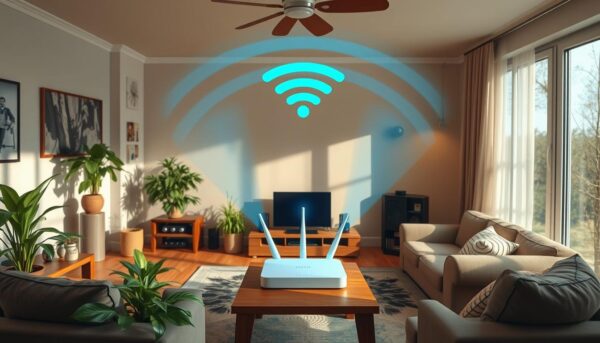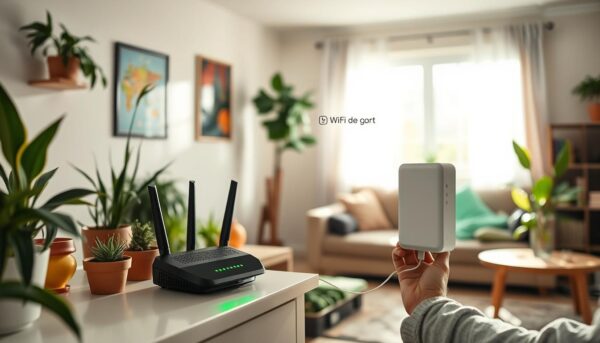✅ Last checked on
Are you tired of dealing with spotty WiFi at home? You’re not alone. With more devices online, WiFi dead zones are common. To fix these, you need to know the causes and find the right solutions.
A WiFi signal booster can help improve coverage. But, it’s key to find the problem’s root. You can visit Wi-Fi dead zones to learn more and find solutions.
Key Takeaways
- WiFi dead zones can be caused by various factors, including physical obstacles and interference from other devices.
- Upgrading to WiFi 5 or WiFi 6 can significantly Improve WiFi coverage and reduce dead zones.
- Adjusting router antennas and relocating routers to central positions can enhance signal coverage.
- WiFi extenders and mesh networks can improve coverage by establishing additional access points.
- Using Ethernet cables can provide superior performance compared to wireless connections.
- Powerline adapters can leverage existing electrical wiring to enhance connectivity options.
Understanding WiFi Dead Zones: What Causes These Frustrating Spots
Several factors can cause WiFi dead zones. To solve these issues, it’s key to know what they are. Physical barriers, distance from the router, and interference from other devices are common reasons. Things like thick walls, big furniture, and metal can block or weaken the signal.
Installing a WiFi extender can help extend the signal. But, it’s important to find out why the problem exists. Devices like cordless phones, microwaves, and nearby WiFi networks can mess with your signal. Knowing these causes helps fix WiFi dead zones and keeps your connection stable.

Some common physical obstacles that can affect WiFi signal strength include:
- Dry wall, which can cause a 3 dB drop in signal strength
- Brick walls, which can cause a 6 dB drop in signal strength
- Concrete walls, which can cause an 8 dB drop in signal strength
Understanding these factors is the first step to solving WiFi dead spot problems. It ensures a strong, stable connection in your home.
How to Identify WiFi Dead Zones in Your Home
To find WiFi dead zones, start by walking around your home with a connected device. Check the signal strength. If it’s weak or gone in some spots, you’ve found a dead zone. Use tools like WiFi Analyzer or inSSIDer to see where your signal is weak.
Signs of WiFi dead zones include dropped connections, slow loading, and poor video quality. To fix these, think about getting a Best WiFi range extender. Here are steps to find and fix dead zones:
- Check your router’s placement and adjust it to a central, unobstructed location
- Use WiFi analyzer apps to scan for nearby networks and identify potential sources of interference
- Consider upgrading your router or using a mesh network system to improve coverage
By following these steps and using the right tools, you can find and fix WiFi dead zones. This ensures a strong and reliable connection in your home. You’ll get better streaming, browsing, and online activities.
Simple DIY Solutions to Fix WiFi Dead Zones
To fix WiFi dead zones, try simple DIY solutions. One effective way is to optimize your WiFi router placement. Place your router in a central spot to boost signal strength and coverage.
Switching channels can also help. This reduces interference from nearby WiFi networks. You can find more tips on optimizing your WiFi settings by visiting this website.
Optimal Router Placement Tips
Here are some tips for optimal WiFi router placement:
- Place your router in a central location to improve signal strength and coverage.
- Keep your router away from physical obstacles, such as walls and furniture.
- Avoid placing your router near other electronic devices that can interfere with the signal.

Channel Switching Techniques
Channel switching is another effective way to fix WiFi dead zones. Switching to a less crowded channel can reduce interference and boost signal strength. Use tools like InSSIDer to find the best channel for your network.
| Channel | Frequency | Interference |
|---|---|---|
| Channel 1 | 2.4GHz | Low |
| Channel 6 | 2.4GHz | Medium |
| Channel 11 | 2.4GHz | High |
By following these simple DIY solutions, you can fix WiFi dead zones and improve your internet connection. Always keep your router’s firmware up to date and use a WiFi dead zone fix for the best performance.
Using WiFi Extenders and Mesh Systems
To boost your WiFi signal and get rid of dead zones, think about using WiFi extenders or mesh systems. These tools can make your internet connection stronger and more reliable at home. WiFi extenders can amplify the signal, and mesh systems create a network of nodes for a better connection.
When picking a WiFi extender or mesh system, think about your home’s size and how many devices you’ll connect. A WiFi signal booster can extend your WiFi’s range. On the other hand, a mesh system offers a seamless and reliable connection. Systems like Eero and Google Nest WiFi are easy to set up and manage with mobile apps.
Here are some key benefits of using WiFi extenders and mesh systems:
- Boost WiFi signal and eliminate dead zones
- Provide a stronger, more reliable internet connection
- Easy setup and management through mobile apps
- Seamless and reliable connection with mesh systems
Some popular WiFi extenders and mesh systems include:
| Product | Price | Features |
|---|---|---|
| TP-Link AC1200 WiFi Extender | $49.99 | Supports up to 30 devices, dual-band |
| TP-Link Deco AX3000 WiFi 6 Mesh | $279.99 | Covers up to 6,500 square feet, tri-band |
Professional Solutions for Persistent Dead Spots
If DIY fixes and WiFi extenders haven’t worked, it’s time for professional help. Managed WiFi services can find and fix dead zones. They offer a complete solution for your WiFi needs.
Professional solutions can include managed WiFi services. They aim to get rid of dead spots. This makes your WiFi stronger and more reliable.
Professional solutions have many benefits. They boost your WiFi signal and make your network better. This means you can work more efficiently and without interruptions.
Choosing a professional solution means better WiFi everywhere. Your home or office will have a strong and reliable connection.
| Solution | Benefits |
|---|---|
| Managed WiFi Services | Improved WiFi signal strength, Enhanced wireless network performance, Increased productivity |
| WiFi Extenders | Extended WiFi coverage, Improved signal strength, Easy installation |
| Mesh Network Systems | Expanded WiFi coverage, Improved network reliability, Easy to install and manage |
Maintaining Strong WiFi Coverage Throughout Your Home
To fix WiFi dead zones and enjoy a smooth internet, keeping your WiFi network in top shape is key. Regular maintenance is vital to avoid weak signals. This way, you can spot weak spots and boost your WiFi.
A WiFi signal booster is a great tool for keeping your WiFi strong. It extends your network’s reach, ensuring a solid signal everywhere. Also, updating your router can significantly enhance your WiFi coverage.
- Regularly updating your router’s firmware to ensure you have the latest security patches and features
- Monitoring your signal strength to identify areas where your WiFi coverage is weak
- Upgrading your equipment, such as your router, to improve your WiFi coverage
By following these tips, you can keep your WiFi coverage strong at home. This way, you’ll enjoy a seamless internet experience.
Conclusion: Enjoying Seamless WiFi Throughout Your Home
Now you can improve your home’s WiFi and get rid of annoying WiFi dead zones. Learn about the reasons for dead zones and use easy fixes or advanced mesh systems. This way, you’ll have a steady internet connection everywhere in your home.
Keeping your WiFi strong means regular checks and updates. Your home network needs care, so stay ahead and adjust as needed. With these tips, you’ll have smooth WiFi all over your home.
Say goodbye to poor internet and hello to a strong network. Your streaming, gaming, and work will be better. Follow this guide to enjoy fast internet wherever you are in your home.